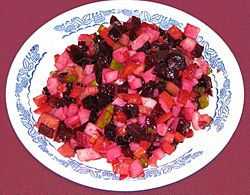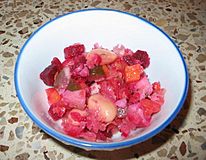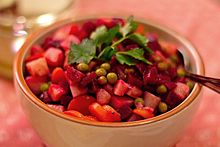Vinegret facts for kids
 |
|
| Alternative names | Russian vinaigrette |
|---|---|
| Type | Salad |
| Course | Appetizers |
| Associated national cuisine | Russian |
| Main ingredients | beet, potato, carrot, onion, sauerkraut and/or brined pickles |
Vinegret (Russian: винегрет) is a tasty salad from Russian cuisine. It is also very popular in other countries that used to be part of the Soviet Union. This salad gets its name from "vinaigrette," which is a type of dressing. However, even though it's called vinegret, people often use just sunflower oil or other vegetable oils instead of vinegar these days. Sometimes, cooks even add a little bit of the salty water (called brine) from pickled cucumbers or sauerkraut for extra flavor!
Contents
What is Vinegret?
Vinegret is a colorful salad made mostly from cooked vegetables. The main ingredients are usually diced red beets, potatoes, and carrots. It also includes chopped onions. For a tangy taste, sauerkraut (fermented cabbage) or pickled cucumbers are added.
What Else Can Be in It?
Sometimes, other ingredients are mixed in to make the salad even more interesting. You might find green peas or beans in some versions of vinegret. These additions make the salad a bit heartier and add different textures.
A Special Salad for Celebrations
Vinegret is a very important dish in many Russian-speaking homes. It is often served as a zakuska (which means a small appetizer or snack) at parties and holiday meals. It's usually placed on the table alongside other popular salads like Olivier salad and dressed herring. These salads are a big part of celebration traditions.
A Bit of History
Even though vinegret is very popular in Russia and Ukraine today, these types of mixed salads were not common until the 1800s. They became popular after people started adopting recipes from Western European countries. At first, the word vinegret just meant any mix of cooked, diced vegetables with a vinegar dressing. Over time, the meaning changed to specifically mean a mixed salad that includes beets.
Old Recipes and New Ideas
Older Russian and Ukrainian cookbooks sometimes mention adding things like mushrooms, meat, or fish to vinegret. However, this is not very common anymore. Most people today stick to the vegetarian version of the salad.
Similar Salads Around Europe
You can find salads similar to vinegret in other parts of Northern Europe too. For example, in North Germany and Scandinavia, they have herring salad and beetroot salad. These salads also use beets as a main ingredient. In Finnish cuisine, there is a salad called rosolli. The name rosolli actually comes from the Russian word rassol (Russian: рассол), which means brine or salty water. This shows how food ideas can travel between countries!



